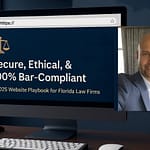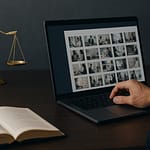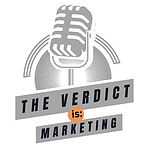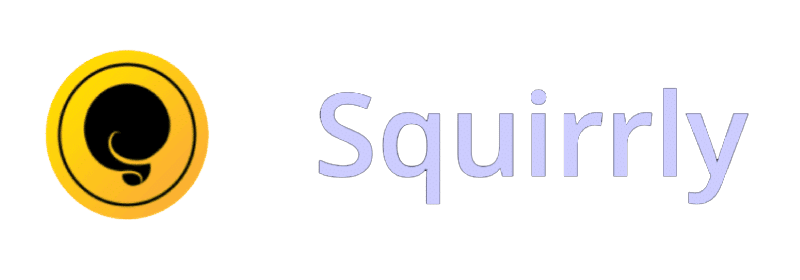
In this episode of The Verdict is Marketing, we’ll be diving into everything you need to know about starting your own podcast! We’ll cover the essential equipment, the best software for recording and editing, how to choose the right hosting platform, and much more. Whether you’re a beginner or looking to improve your podcasting game, we’ve got you covered with tips and tools to get your show up.
Podcast Resources:
Squadcast – Click to use Squadcast
Show transcript:
Kim: Hello and welcome to the Verdict is Marketing podcast. I’m Kim, your host, founder of LawBARD. Ever wonder what it takes to start a podcast? Join us as we break down the essentials. From microphones, editing software, to hosting platforms and distribution strategies, we’ve got you covered. Tune in to discover how to turn your ideas into a podcasting sensation. Joining me today to share their expertise are LawBard’s Co-Founder Todd Blackman and our Guest, Expert Contributor Josh Vega. Welcome and thanks for joining us today. Todd and Josh, the podcast is yours.
Todd: Yes I’m really stoked about having this conversation. Been working with a lot of different clients recently and podcasting seems to be an area people aren’t super comfortable with or don’t know what they need to do to get started or what they need. So, I think it’s a really good topic.
Todd: Where do you want to go with it, Josh?
Josh: We can start in the beginning. I don’t know if you have any initial questions that, that some of your clients give to you. I know I get this question all the time and I used to be an auto audio engineer, so that helps a lot with giving advice as to how to set up your podcast.
Josh: I have a lot of experience with audio equipment. And based on the type of podcast that you want to do, the number of guests, whether it’s in person, whether it’s online or remote like this, whether it’s just audio or video the answers and questions can range by a big variety. So I don’t know if you want to talk about maybe gear first, what you’re going to need, and we can get into that.
Todd: Yeah that’s actually a good place to start because there’s definitely just the minimum amount of stuff you need. Also we can, discuss a little bit more about the environment to do you’re where you want to do a podcast. You want to be a quiet environment, maybe have some kind of sound dampening.
Basic Podcast Equipment & Best Locations to Get Started
Todd: Those types of things. Yeah, we’ll start with the equipment list. What’s your just basic startup recommendation?
Josh: First thing is I would try to find a quiet room. If you have an office or a small space that would be my recommendation. And that’s because you want to have a minimal reverb. So if you’re in a big room that’s spacious, I’m sure if you’ve ever been in an empty house and you talk, that you’ll hear an echo or a reverb.
Josh: The smaller the room, the better. Also, the more things are in the room. So if there’s a couch that absorbs the sound, or like you were mentioning, some sort of sound panels or padding, you can also add that to the room. I know a lot of people when they’re starting out, they don’t necessarily Even know how to wear the place to sound panels, which ones to buy.
Josh: So I would just recommend if you’re just starting out, best thing to do is just find a small room. And for people who are just starting out again, I don’t recommend to go crazy on equipment. A lot of people, they get excited about starting a podcast and they overspend. They make it overly complicated. And I want you guys to just start out with the basics.
Josh: I would recommend just a decent mic, especially if you’re doing an audio only podcast just something that’s going to make your voice sound good, have good quality. And you can, you can even use your laptop audio there. They are getting pretty good nowadays as far as like isolation goes and depending on the software that you use, it can help with, audio isolation effects, but definitely getting a dedicated mic does help. And to make it as simple as possible, I would recommend a USB mic. So there are all types of mics that you can get. There are XLR mics, TRS mics, condensers, et cetera. Mics that are made for instruments, mics that are made for vocals.
Josh: So to keep it simple, Just get a USB mic that’s made for vocals. You can just plug it into your computer and it should just work. Depending on the software that you’re using to record your podcast, you should just be able to just easily select it from a dropdown. And normally it’ll say, do you want to use your computers mic or your, for example, use a Blue Yeti.
Josh: So it’ll say, do you wanna use your Blue Yeti mic? And so you just choose that. And that should improve your auto audio quality by, by a lot. The next thing I would recommend is definitely headphones. So there’s a few reasons that you want to get headphones and that’s one so that you can monitor your own audio.
Josh: Like right now when I’m talking, I can hear my voice through my own headphones. That allows me to analyze if I’m talking too loud, too low, if there’s background noise in the room. If I move my chair, I can hear it creaking a bit. Hopefully you guys aren’t picking it up, but it allows me to hear.
Josh: Listen to how I’m coming off on the show. And then the other reason is so that there’s no echo. So if the audio from the other participants is coming out of your speakers instead of your headphones, then your mic is also going to pick that up. And that’s going to give you this kind of feedback effect and echo, and that can be removed by certain software, but just having a pair of cheap headphones, like the ones I have right now are 9 headphones in ear wired from Amazon. So nothing too crazy. And if you are going to be doing a video podcast, then maybe a cheap web webcam to start. But honestly, nowadays, Again, if you’re using like a Mac or most decent computers nowadays have a pretty good webcam on them already.
Todd: You can even use your iPhone now. So if you have a Mac and an iPhone, you can connect your iPhone to your computer. It will sync and let you choose that as a webcam. They make a little adapter that you can put on top of your laptop or anywhere you want or tripod, and you can use your iPhone. And actually it looks pretty good.
Todd: A lot better than most professional cameras. So I would definitely recommend those three things to, to start. Yeah, because with myself with the mics just standard USB mic seems to work really well. You don’t have to break the bank. You don’t have to spend a ton of money. Headphones are essential. I’ve I highly recommend headphones when I’m setting up a podcast for a client.
Todd: I basically say it’s a requirement. You gotta have it. Because without it, It’s always seems to be issues with the, sound and sound quality and them not being able to heal yourself and background noises and that kind of thing. So yeah, all good points. Let’s talk about I know you talked about the camera, but if you’re going to do video lighting, do you, You know that and that’s I see everybody going out and buying ring lights and stuff like that But what’s your recommendation on that?
Josh: So, if you’re going to do video, definitely for the most part, unless you just have a very well lit room or you have a nice window and it’s a bright day you’re mostly going to need some sort of light. And I would, Again, to keep it simple there, you have a million and one options, but to keep it simple, you can definitely get a cheap ring light from Amazon.
Josh: And for the most part, that would be good for both men and women because it will just evenly light you. If you want to get a little bit more complicated than you can, And I’m sorry, you probably hear my dogs in the background. That’s because I’m dog sitting today. And yeah, that’s part of it too, make sure they’re external noises as well.
Josh: But so if you want to get a little bit more complicated and custom with your lighting, then you can get two. Lights led panels or soft boxes. Like I, for example, I’m not using them at the moment and I, most people probably listen to this on audio anyway, but I have two lights next to me away from the camera and I can control each light as far as luminance goes, and that way I can really customize how much light is on each side of my face and I can also, there’s a trick that I do as well. I have three monitors in front of me. And so I can essentially light myself up if I put a nice white screen in front of me. So that that helps a lot, but yeah if you’re doing video, same as with a microphone, you want to. Have the highest quality as possible for your voice, your vocals, and for your, the visuals for your audience to see.
Podcast Software
Todd: Excellent. Yeah. Good point. Also the other kind of critical piece to podcasting other than your equipment, your mic, your headphones, your lighting is your platform, your software. At LawBARD we use a Squadcast. We love it. We use it. It works in combination with Descript, which makes editing very easy.
Todd: We’ll definitely put some links in the show notes to those platforms cause they’re really a rock solid. But there’s a bunch of other ones out there. You could even get away with Zoom, doing a Zoom call or a Teams call. It’s just a little bit more difficult on the back end to try to edit those transcripts. They work and you can do it on the budget. Anything that you’ve used that you like?
Josh: Yeah. And it all really depends on, again the type of podcasts that you’re hosting. So definitely for remote podcasts, you want to use some sort of service. Yes. Riverside, StreamYard, and Restream. Again, how you said you can use zoom or anything that essentially you can have multiple people on camera.
Josh: Even something that you can share your screen, depending on, again, on the podcast, you may want to show viewers something that you’re referring to. Sometimes your guest wants to bring something to talk about, a graph and, or an image, and you want to be able to pull up or share their screen. I personally have used StreamYard. Restream and Riverside, and they all have their pros and cons again. If you’re starting out and you want something easy and intuitive to use, I would use Restream and that is because it’s just very easy to set up. It’s very cheap. They actually have a free plan in which you can get started without any subscriptions to test it out.
Josh: It’s free indefinitely. It’s just that they will, they’ll put like a watermark. under your video. And I think they cap you out at, I think four guests. So if you want to have more than that, but for the most part, you’re not having more than four guests on a podcast. It’s not very common. So, Restream is a great one to get started. It will give you a lot of different options as well. If you want to do on screen texts if you want to brand the show if you want to have live streaming to multiple different platforms like Twitter, Facebook, and you want a live audience, if you want them to ask questions, then you can have them ask questions in the chat and bring up those questions on camera so other guests can see them.
Josh: StreamYard is very similar. It’s just a competitor. They have very similar features. Riverside is where it gets a little bit more advanced still very easy to use, but Riverside will probably give you more features, a little bit higher quality output. And especially if you’re into using a lot of the AI features that like Descript will give you, Riverside has a lot of those as well.
Josh: So one cool one is, for example, you record the show. And then afterwards in Riverside and in Descript, you can do this as well, but it will analyze your whole podcast and then it will pull out clips, vertical clips for you to use to share on social media. It will add subtitles and do a lot of the work that an editor will do.
Josh: And also, the main difference as well is that it, it does remote recording, meaning that versus depending on your internet connection, like Restream or StreamYard if the quality goes out for. Low internet speed Riverside will actually be recording every individual’s audio and video onto their computer. And so you don’t have a loss of quality. So again, it really just depends on your price point. If you’re just getting started, what type of basic or advanced features you need for anyone starting out? Restream is great for anyone moving into more of a professional Realm, I would use probably Riverside.
Josh: But there’s even more out there that I haven’t used. So there’s a ton that are coming out, but those are three that I think most people are using at the moment.
Podcast Preparation
Todd: Yes. Yeah, I agree. I’ve used all of them. They’re all great. They’re all really solid. Another thing I wanted to just make sure we cover is preparation. When I’m working with the client and I just want them to feel comfortable, so I, it’s helpful to provide some kind of outline, even if it’s very general just so they can get in their head, what they want to do. The discussion is going to be about and, making sure that they’re set up properly and everything is, going to go smoothly. It’s just that peace of mind. It’s really good. Do you have any recommendations for helping prep a client or a podcast?
Josh: Yeah, what you said is pretty much one of the biggest things that you want to do as far as podcast prep. Again, when you’re starting out, you want to be as organized and as structured as possible, or else it can just, can rant for a while and just go off the wall and forget what the subject matter was that you were talking about.
Josh: And I definitely recommend having some sort of at least bullet points of questions and topics that you want to get into with your guests so that can, they can at least start thinking about it a few days prior. To be candid, you provided me with some things that you wanted to go over for this one, and it allows me to, while I’m driving, just think of some answers or topics that I want to get into on the show, and maybe not only that, but it also, It might be good to provide some questions and topics prior.
Josh: And then the guests might also have some suggestions as well. They might say let’s also talk about this, cause I see that you haven’t included it on here. So it’s good for both parties. The other thing that some people do just to get people comfortable, a lot of people, especially when it’s video a lot of people aren’t very good on video or they and it’s good to sometimes start to show five minutes prior. For example, StreamYard, Restream, and a few of these platforms, you can get into, you can get the shows preloaded or the guests preloaded prior to the show. And you can just have just a conversation with them real quick, just to get used to talking.
Josh: Get used to them being on camera and also make sure audio quality and video quality is good so that when you don’t hit start, you don’t run into problems mid show. So it’s good to just start talking with your guests prior, have them warm up and by the time you start to show and say three, two, one, they don’t freeze up on you. So that’s what I recommend. Yeah.
Todd: Yeah. Good advice for sure. Okay. I think pretty much covers most of what, the basics in my opinion having finding the right software that fits well with your workflow, having the right equipment you don’t have to break the bank. It can be real easy. And And then the final thing I think really just want to touch on really quick is your hosting platform.
Podcast Hosting Platforms
Josh: Where are you going to put, where are you going to put the files? Where are you going to host the platform? And a lot of them are, these companies are making it really easy to do Google. Pretty solid. Apple now is getting into the game. There’s also Spotify which is becoming very popular.
Todd: You got any of those you want to talk about?
Josh: Previously before, and there’s a ton of these, but the one I used previously before was Buzzsprout. And so just so everyone knows what you’re referring to is that, once you, it’s similar to music, it’s how do I get my music on all these different platforms for people to listen to?
Josh: Because most people listen to podcasts on pod Apple music or not Apple music, but Apple services or Spotify and so you just need a distribution platform And so buzzsprout basically what that is that you sign up for a I think it’s a pretty cheap membership But it allows you to upload your audio or video file and it will distribute it to All the different podcasting platforms and you can title your show.
Josh: You can put descriptors and tags so that other people, if they’re searching on those platforms, they can easily find you. And so it basically, it’s syndicates your show out to all these different places. You can even run ads through these platforms. So once your show gets big enough you can partner with ad services if you want to monetize your show.
Josh: But The Route is a really good one. Again, super easy and user friendly. I know there’s a few out there, but I haven’t really used any other ones besides that. If you just Google podcast distribution, software or website you’ll come across a few and I’m sure they all have their pros and cons. But Buzzsprout for me seemed to work just fine. It had everything I needed. So that’s the one I would recommend.
Todd: Excellent. All I pretty much, I think covers everything. Josh was great chatting with
Marketing Your Podcast
Josh: One more thing. Marketing. We did marketing together for people who don’t know, I used to work under Todd. And he showed me a lot about marketing and in that time I’ve learned a few tricks here and there, but one thing that I would recommend, because obviously once you create a podcast and you get it distributed, et cetera, it doesn’t matter how high quality it is if you don’t know how to get it in front of people’s faces, it’s going to be hard for anyone to find your show.
Josh: Not a lot of people really just go on Spotify or Apple services and use the browse feature to find new shows. A lot of it is that they come across it somewhere or a friend refers them. And I would recommend taking advantage of all these different social media platforms, like Instagram, TikTok, YouTube, Facebook, and definitely consider creating a video version of your podcast alongside your audio.
Josh: And that is so that you can go on these platforms and upload clips. And, this is the. One of the main ways that a lot of podcasts are blowing up, sorry, my dogs here are fighting. But so yeah, what I recommend is if you can do a video version of your show, even if you can’t do a video version, at least record the audio and put some sort of image.
Josh: Oh, sorry, man. Let me put this dog away and come back to you with this one. So yeah, let’s rewind and talk about so marketing your podcast. So once you record, once you get your audio equipment and once you have your show set up and you get it distributed onto all the different platforms, I do recommend also, Posting your podcast, at least in clip form on different social media platforms.
Josh: This is how a lot of people nowadays are finding new shows to watch. They’ll see a clip of an interesting segment on social media, and they will then click on the bio of that social media platform and find the full episodes on whatever platform they’re on. So, if you can do a video version of your show, or if you can’t do a video, at least record the audio, put an image on it, put some captions and try to find some of the best, most intriguing clips to use and share those on social media. That should help with marketing your podcast a bit. Yes.
Todd: Yes, I agree. And that’s a, actually a great subject for a whole complete podcast. The marketing, cause it, there’s a lot to it. It’s not hard, it’s, People don’t need to be intimidated by it. It’s just doing the steps necessary to get, some notice in social media is probably the easiest and best thing to start with.
Todd: If it’s something that you’re also selling products and, other products, other attachments to that podcast then you may want to spend a little money marketing, maybe AdWords or something like that. But most of the time that social media seems to be the most affordable and easiest.
Podcast Editing
Josh: Yeah, exactly. Oh and real quick to edit when it comes to editing as well. A lot of people get scared of that as they record and they don’t know what to do afterwards as far as editing goes. And there are a lot of platforms online that use AI nowadays to really edit your shows like Adobe podcast.
Josh: I’m sure you’ve heard of them. They’re still in beta, I think, but let’s say you have a show and you have some audio issues and you don’t necessarily know how to edit audio. You can upload it to Adobe podcast and it will clean up your full podcast episode, get rid of the background noise. It will compress the vocals, make everything sound nice.
Josh: Even with certain. platforms like Adobe Premiere you have plugins that will edit your whole show. If you have multiple guests, you can say, I have three guests on my show, you put in their names, and then it will go through the whole one hour podcast or however long it is, and it will cut All their individual scenes and when they’re talking and it will basically edit it like like an editor.
Josh: So you could save money doing that as well. You can use services like final cut or free software that you have on your computer. But Yeah, that’s another thing and probably a a whole episode on its own as far as how to edit the podcast. Yeah. Yes.
Todd: Yeah. Great. It is getting way easier. I remember struggling through, timelines and Adobe premiere and final cut. But now A lot of times we use Descript a lot and you just edit the text file. And it actually, it’s just, it’s amazing. And it will, AI will clone, comb, will comb through it. They’ll take out the ums, uhs and pauses and stuff like that. Just automatically. It’s just amazing. I love where it’s going. It’s making it easier. It’s making it accessible for the everyday person to be able to do like really good quality podcast.
Josh: That, that text to edit is basically, it’s a big game changer, quite honestly you, anyone can do that. And I forgot about that one, but yeah, that’s if you’re going to edit use Descript for sure, or any other platform that allows text editing because it makes it very easy.
Todd: Good. Cool. All right. Anything else? I think we did a nice discussion.
Josh: That’s it. Thanks for having me on the show. Anytime you need me on or when you want to get into a little deeper into some of these subject matters I’m willing to come and talk about those next time without the dogs here, kill each other.
Todd: Absolutely. No, we’ll do that. Okay. Kim, you want to just take us out on this?
Kim: Sure. If you would like a full transcript of today’s episode, please visit LawBard.com backslash verdict. Please check the show notes for additional links to resources we mentioned in the podcast. Thanks to LawBard’s co founder, Todd Blackman, and our Guest Expert Contributor, Josh Vega, for joining us today.
Thank you for listening. Feel free to drop me a line at Kim at LawBard. com or visit us anytime at LawBard. com. Until next time, the verdict is marketing. Is adjourned.












